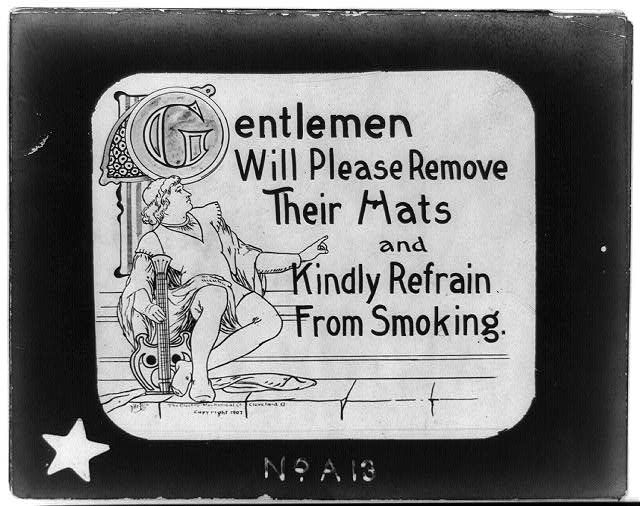
Etiquette comprises rules to follow and manners expected of a person in social or professional situations. Today, the components of etiquette have been rebranded as “soft skills,” the behaviors that help people work well with others.
Just like the terms we use, the actual context of using polite behavior in public varies across time, places, settings, and cultures. Modern advice blogs, newspaper columns, and books as well as old etiquette manuals are great primary sources for demonstrating to students the following four key lessons about rules for behavior.
1. Etiquette for upgraded technology often requires new rules of behavior
Today, as new forms of digital communication appear regularly, the rules for courteous correspondence adapt and evolve. Ask students to search the internet for rules of etiquette for social media and compare these modern lists to ones from the past. Students will soon recognize that the lists vary depending upon the context, background of the author, and intended audience. Next, compare the 21st-century rules for communication to the rules in old etiquette manuals. For example, these manuals describe etiquette for using “antique” technology such as land-line telephones and written letters.
In the 1960 McCall’s Book of Everyday Etiquette, several pages were dedicated to telephone manners, a “new” technology that reached the majority of American homes in the 1950s. In this excerpt, the book describes the proper procedure for using the telephone when visiting other people’s homes:
“If you are visiting, ask your hostess permission before you make any telephone call. If you must make a long-distance call or a number of local calls, you should pay for them. Ask the long-distance operator what your call cost and leave the money with a note by the telephone, or give it to your hostess.” (p. 87)
Cell phones and texting have certainly made this advice nearly obsolete.
Vogue’s Book of Etiquette and Good Manners (1969) dedicated an entire chapter to written correspondence—the proper stationery, correct forms of addressing all types of people, and model letters for various occasions. According to this book, typewritten letters were viewed as cold and impersonal; handwritten letters were preferable. Who hand-writes letters today?

Credit: Library of Congress
2. The rules for males and females are rarely the same or equal, but hopefully that is changing
Vogue’s Book of Etiquette and Good Manners and many advice books from the 19th and first half of the 20th century describe in detail how men and women should write their names on correspondence and introduce themselves face-to-face. How women were addressed communicated their relationship status; for men, only their professional status was noted. For example, Linda Smith was Miss Linda Smith before marriage but became Mrs. Tom Jones when she married Tom Jones. If Linda divorced Tom, she was supposed to be Mrs. Smith Jones, a combination of her maiden name and her husband’s name. Ms., a relationship status-neutral title for women, didn’t become popular until the 1960s.
Men didn’t have to follow these complicated rules: Mr., Dr., or other professional titles were used. Today, men and women can communicate their relationship and professional status in social media with a click of the mouse.
In relationships, women and men were expected to follow different sets of rules. Ask students to consider how relationship etiquette varies for men and women in the 21st century before examining historical examples. Here are a couple of examples illustrating the different expectations for men and women.
- In 1954, etiquette expert Amy Vanderbilt noted that “dating for boys does bring with it increased financial responsibilities. While a certain amount of Dutch treating goes on, especially in group entertainment, a boy usually does pay for the entertainment of his special date. If his allowance is not adequate for his participation in the social activities of his high school group and if his parents cannot comfortably increase it, then after-school jobs must provide the difference.” (Amy Vanderbilt’s Complete Book of Etiquette, 1954, p. 539)
- In the 1924, a booklet titled Hints on Etiquette noted that “no young girl should go to a dance unattended, or with a masculine escort alone. Her mother or some chaperone should go with her to a public ball and a private dance she must at least be accompanied by her maid.”

Credit: Library of Congress
3. What is rude is one culture or historical era is often okay in another
Every culture has its own rules for polite greetings or mannerly eating. Some appreciate firm handshakes, others bow or include hugs and air kisses. In the United States, slurping soup or noodles is impolite, but in many Asian cultures slurping is expected. Cultural differences are not unique to the 21st century. In the 19th century, many Americans were still eating with only a knife and a spoon and had not adopted the “new” European fashion of using a fork, as this excerpt illustrates.
“If you wish to imitate the French or English, you will put every mouthful into your mouth with your fork, but if you think, as I do, that Americans have as good a right to their own fashions as the inhabitants of any other country, you may choose the convenience of feeding yourself with your right hand, armed with a steel blade; and provided you do it neatly, and do not put in large mouthfuls, or close your lips tight over the blade, you ought not to be considered eating ungenteelly.” (from The Young Lady’s Friend,1838, by Mrs. John Farrar)
In 1884, etiquette writer Mary Wilson Sherwood warned readers that expectations of proper behavior were different in Europe. She was concerned about the reputation of American men—and especially women—traveling in Europe and at American vacation resorts when she stated “The wholesale violation of good manners and of etiquette is shocking, and it has led to universal misapprehension on the part of observing foreigners as to the morals of American women.” (Etiquette, The American Code of Manners, 1884, p. 159)

4. Different generations often have different rules for behavior
Rules of etiquette have always changed with the times, as this advice book noted in 1963:
“However, just as many other customs and styles have changed radically in the past fifty years, so, too, have many of the rules for correct and gracious behavior. For example, modern etiquette takes into consideration that most homes are servantless, that many wives work, the teenagers have greater freedom than ever before. To sum up, life in the 1960s is faster, more informal and freer than at any time in history.” (Dell Purse Book, 1963)
As technology and cultures change, the rules of etiquette can evolve very quickly. Parents and grandparents often hold very different views on what is proper. Your students will be eager to describe all their daily habits that shock or offend their elders. Ask them to list the differences, justify their “new” rules of behavior, and consider what caused the changes—new technology, evolving views of sex/gender equality, or wider cultural shifts.
Where to find old etiquette books
Many advice books published before 1923 are available full-text, online. Internet Archive is just one excellent resource. For advice books published after 1923 that are not in the public domain, check your local library and bookstores. My collection of late 19th and 20th century etiquette books was acquired from used book, thrift, antique stores and yard sales!
Seeking more curriculum and activity resources?
Sign up for a free 30-day day trial of Active Classroom
References
(1969). Vogue’s book of etiquette and good manners. New York: Condé Nast Publications.
Bevans, M. (Van Doren). (1960). McCall’s book of everyday etiquette: a guide to modern manners. New York: Golden Press.
Day, C. William. (1924). Hints on etiquette and the usages of society: with a glance at bad habits. New York: Dutton.
Farrar, J. (1837). The young lady’s friend. Improved stereotype ed. Boston: American Stationers’ Company.
Sherwood, M. E. W., Cairns Collection of American Women Writers. (1884). Etiquette, the American code of manners: a study of the usages, laws, and observances which govern intercourse in the best circles of American society. New York: G. Routledge & Sons.
Vanderbilt, A. (1954). Amy Vanderbilt’s complete book of etiquette: a guide to gracious living. Garden City, N.Y.: Doubleday.
Cynthia W. Resor was a middle and high school social studies teacher before earning her Ph.D. in history. She is currently a professor of social studies education at Eastern Kentucky University. She is the author of a blog, Primary Source Bazaar, and three books on teaching social history themes using essential questions and primary sources: Discovering Quacks, Utopias, and Cemeteries:Modern Lessons from Historical Themes, Investigating Family, Food, and Housing Themes in Social Studies and Exploring Vacation and Etiquette Themes in Social Studies.